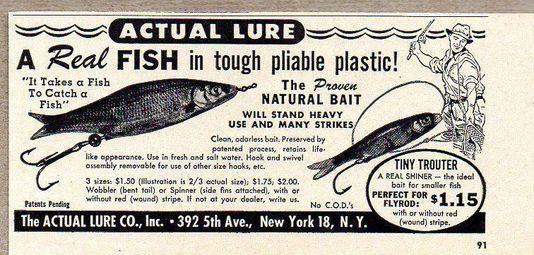
4 minute read
Buried Treasure
My grandfather was not a fisherman, more of a trader. He picked up items back in the 1950's and 1960's that most walked past.
For example, in 1961 he bought a race car without the engine or transmission. I was about eight and had a great time steering that car around the yard while dad pushed. He later sold the car like was the fate of all the interesting things he bought. Years later, I found an exact photo of the car that was a 1930's racer. That body with wheels would be worth a fortune now.
On another trading trip, grandpa brought home a tackle box he had traded something for in 1965. That, of course, went to me, the family's fisherman. The box was full of old lures and plastic boxes of hooks, weights and bobbers. I was elated and made sure to hide the box before it was traded for some other treasure.
I closely surveyed the tacklebox's contents at home and found several interesting items, mostly old wooden lures. But one was different and absolutely unique. I picked it up and studied a real fish mummified in layers of plastic. The lure had a nylon leader out of its mouth and a beaded treble hook from out of its anal cavity. I put that lure in a special box and forgot about it.
Years later, the unique lure turned up and I decided to do some research. By then we had the internet and lots of lure collector sites. I indeed found my lure and its history.
A story published in Field & Stream and written by Joe Cermele in 2011 stated: "Preserved baits had already been around for over 50 years when on August 15, 1939, Englishman F.J. Nevison patented a method for preserving fish, frogs, etc. in cellulose, an early plant-based plastic that is said to be the most abundant organic polymer on Earth.
World War II interrupted his production plans, but after the war ended, his dream was realized by starting the Actual Lure Company in New York City. From the late 1940s until the late 1950s, Actual Lures became fairly popular with American anglers."
Minnows, frogs, and insects were preserved in plastic and then rigged into fishing lures, selling for $1.75 each, expensive for that era. Some cast the lure and retrieved while others fished the minnow and grasshopper under a bobber or float.
Time has yellowed the plastic on my lure, but the plastic was clear and the minnow visible when brandnew. Advertisements claimed that the fish's real eyes were shiny, but the eyes had rotted out by the time I owned this lure.
My lure was named the "Skip Dip Spin-Ster" model, a four-inch-long golden shiner preserved in plastic with molded fins to make it spin in the water. The molded fins had long been gone by the time I found this lure, but it was still quite a keepsake that I still have today.
I saved another lure from that box, a 1932 Dingbat. But it was beyond saving, and years later, Jack Looney, famed lure collector gave me a betterpreserved version. I caught a seven-pound largemouth bass on that lure from lake Fork Texas and retired it.

Sadly, other lures in the box were used and lost through the years, a couple that would probably be worth quite a sum of legal tender.
Lure collectors claim the next big find in antique lures is likely sitting in someone's cellar or attic. That old tackle box could have a rare lure that might pay off your mortgage. The problem is that there are thousands of vintage wooden lures and some will try to profit off you. I heard of a genuine wooden lure from the 1950's being sold for over $100.00. Most collectors would have sold it for $20.00.
There are several good books and websites on purchasing vintage lures. Make sure you check before buying that beautiful lure made before you were born. There are pages on Facebook dedicated to selling and trading vintage fishing equipment. These groups have other items like advertisements that may have stood in a sporting goods shop or hardware store, once a great place to buy fishing tackle.
Buyer beware, Often the best-looking lures are not worth as much as that plain-looking version that fewer people bought. The market was flooded with many of the more popular types generally boldly painted in beautiful colors.
Some of us may be surprised by what is being sold as antique lures, namely versions we bought in the 1960's and 1970's. For example, collectors on vintage lure websites are constantly trading various Heddon, Arbogast, Bill Lewis and Storm lures, many I still have in tackleboxes. Some collect by the company while others go for a full collection of lure types like topwater's or divers.
My Skip-Dip-Spin-Ster encased minnow is not worth a great deal, but it was interesting to research and find out how, where and when it was manufactured. Besides, it came from grandpa and to me, that makes it valuable.
Kenneth L. Kieser
(Left) Fishing gear is ready to use.
(Right) This is a 1950 era advertisement about my treasure. (Photo: Courtesy of Kenneth L. Kieser)








